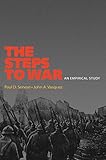The Steps to War : An Empirical Study / John A. Vasquez, Paul D. Senese.
Material type: TextPublisher: Princeton, NJ : Princeton University Press, [2008]Copyright date: ©2008Edition: Course BookDescription: 1 online resource (336 p.) : 1 line illus. 38 tablesContent type:
TextPublisher: Princeton, NJ : Princeton University Press, [2008]Copyright date: ©2008Edition: Course BookDescription: 1 online resource (336 p.) : 1 line illus. 38 tablesContent type: - 9780691138923
- 9781400837830
- 355.02/7
- JZ6385
- online - DeGruyter
- Issued also in print.
| Item type | Current library | Call number | URL | Status | Notes | Barcode | |
|---|---|---|---|---|---|---|---|
 eBook
eBook
|
Biblioteca "Angelicum" Pont. Univ. S.Tommaso d'Aquino Nuvola online | online - DeGruyter (Browse shelf(Opens below)) | Online access | Not for loan (Accesso limitato) | Accesso per gli utenti autorizzati / Access for authorized users | (dgr)9781400837830 |
Frontmatter -- Contents -- List of Figures and Tables -- Preface -- Acknowledgments -- Introduction -- I. Foundations -- 1. The Steps to War -- 2. The Evolution Of A Research Program: Research Design -- II. Territory and War -- 3. From Territorial Claims to Territorial Disputes: Testing for Selection Effects -- 4. Territory, Contiguity, and their Interaction: A Contingent Model of Interstate Conflict -- III. Power Politics And War -- 5. The Probability Of War Between Nation-States -- 6. The Probability of Crisis Escalation -- 7. Exploring Interactions in the Steps to War -- IV. Conclusion -- 8. Explaining War, Thinking about Peace -- References -- Name Index -- Subject Index
restricted access online access with authorization star
http://purl.org/coar/access_right/c_16ec
The question of what causes war has concerned statesmen since the time of Thucydides. The Steps to War utilizes new data on militarized interstate disputes from 1816 to 2001 to identify the factors that increase the probability that a crisis will escalate to war. In this book, Paul Senese and John Vasquez test one of the major behavioral explanations of war--the steps to war--by identifying the various factors that put two states at risk for war. Focusing on the era of classic international politics from 1816 to 1945, the Cold War, and the post-Cold War period, they look at the roles of territorial disputes, alliances, rivalry, and arms races and show how the likelihood of war increases significantly as these risk factors are combined. Senese and Vasquez argue that war is more likely in the presence of these factors because they increase threat perception and put both sides into a security dilemma. The Steps to War calls into question certain prevailing realist beliefs, like peace through strength, demonstrating how threatening to use force and engaging in power politics is more likely to lead to war than to peace.
Issued also in print.
Mode of access: Internet via World Wide Web.
In English.
Description based on online resource; title from PDF title page (publisher's Web site, viewed 30. Aug 2021)


